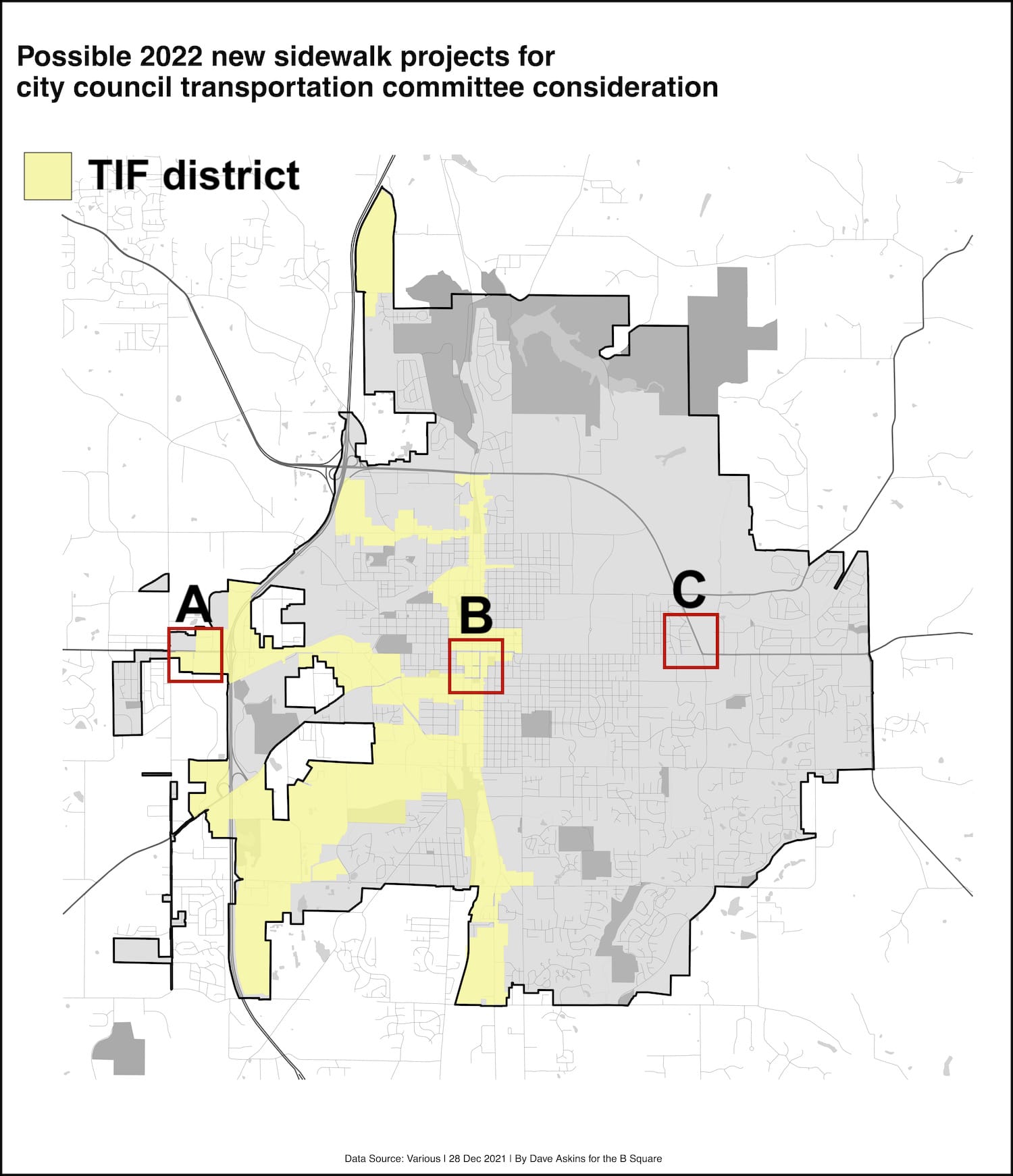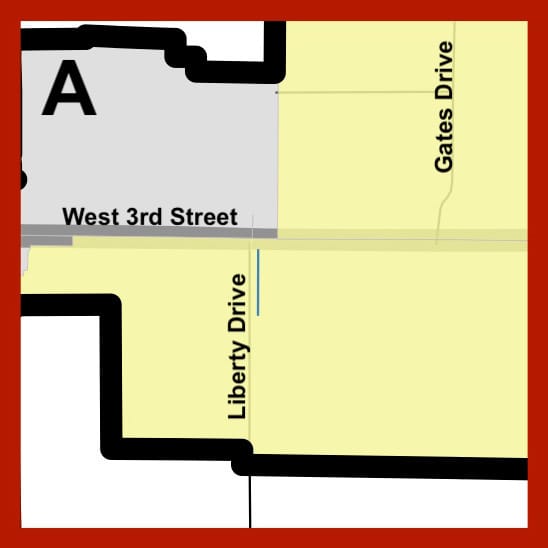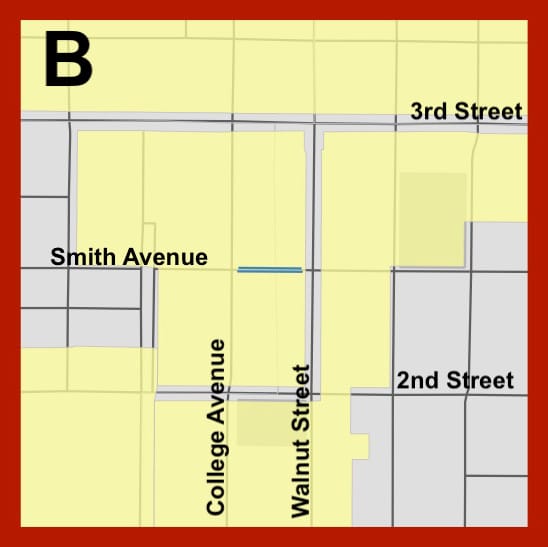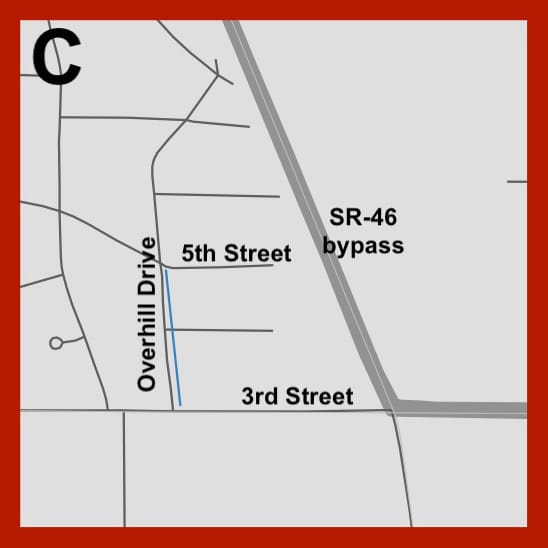Sidewalk projects: Bloomington city council committee set to apply new criteria for decisions on limited funds for 2022





At noon on Jan. 6, the Bloomington city council’s transportation committee is scheduled to meet to continue its work on allocating money to add new sidewalks and traffic calming to the city’s street network.
Since 2007, a total of about $4 million has been allocated for new sidewalk projects, which reflects incremental increases each year starting in the low $200,000s in 2007.
For the 2022 budget year, the city council has $336,000 in available sidewalk funding to allocate.
At its Dec. 9 meeting, the committee voted unanimously to adopt a new approach to ranking potential projects.
It’s not just that the ranking criteria have been revised. The starting point is different.
Previously, the approach has started with a list of projects that have been requested through various channels. Those projects have been ranked, based on an objective metric. The metric has included factors like cost, safety, roadway class, pedestrian usage, destination points, and linkage to existing facilities.
The newly adopted approach starts by analyzing all locations in the city, based on a mathematical expression. The output of that expression is a collection of areas that would benefit most from an added sidewalk.
At the Dec. 9 meeting, no decisions were made on recommendations for projects to be funded for the 2022 budget year.
It’s on Jan. 6 when the committee will likely dive into discussion of individual projects. The committee’s recommendation will eventually go to the full council, which will need to approve the funding of projects.
Based on the new approach to selecting projects, the staff recommendation for new projects to fund in the 2022 budget year looks like this:
- Liberty Drive: east side of the street between 3rd Street and the Whitehall Plaza parking lot.
- Overhill Drive: east side of the street between 3rd Street and 5th Street.
- Smith Avenue: north or south side of the street between College Avenue and Walnut Street (The meeting information packet indicates “east or west side” of the street, but that is almost certainly a copy-paste error.)
- Fund the resident-led traffic calming project process (A note in the meeting information packet puts the amount at $100,000.)
The recommended sidewalk project selection is based on the use of the following expressions:

In 2022, it’s likely that not all of the $336,000 will go towards the staff-recommended new projects. That’s because in any given year, the city council has typically tried to make sure that projects that were funded in the previous year, and that now have their design work done, get the funding they require in order to get built.
In that category this year is a sidewalk project on the east side of South Walnut Street, from Winslow to Ridgeview Drive.
Senior project engineer Neil Kopper told the transportation committee at its Dec. 9 meeting that bids for the construction of the South Walnut Street project had not yet come back. A clearer picture of the construction cost for that project should be in focus by the Jan. 6 committee meeting.
The new initial focus on geographic place, instead of requests, had emerged in large part because of an analysis done by Bloomington resident Mark Stosberg last year. Stosberg’s analysis questioned the role of councilmembers in advocating for projects that serve their constituents.
District 4, which is represented by councilmember Dave Rollo, a longtime member of the sidewalk committee, was home to more sidewalk projects than other districts.
A reconsideration of the role that the council plays in the sidewalk allocation process led to the dissolution of the council’s sidewalk committee and the assignment of the sidewalk committee’s tasks to the city council’s transportation standing committee.
Rollo was subsequently appointed to the transportation committee.
At its Dec. 9 meeting, the transportation committee did not adopt the new method for evaluating projects without some deliberation.
At the Dec. 9 meeting, Rollo supported the new evaluation metric, which selects projects based on the benefit to the greatest number of people—it’s based in part on density.
But Rollo said he still values the “anecdotal” perspective, even if generally he thinks decisions should be driven by data. “I’m all for objectivity and data,” Rollo said. He added, “But there are some neighborhoods without sidewalks completely—there are no sidewalks, because they weren’t prioritized when the neighborhood was built out.”
“We have to pay attention to density,” Rollo said, “but I guess what I’m saying in terms of anecdotal evidence is that if you if you visit a neighborhood, and people say, You know, we would like to walk…out of our neighborhood, and there are no sidewalks, but there is a collector street…that would be a really good candidate for a sidewalk.”
The money for the sidewalk project comes from the city’s alternative transportation fund (ATF), which was established in 1992 as part of the same ordinance that created the residential neighborhood parking permit program.
According to the residential neighborhood parking permit ordinance, “funds received in excess of the annual cost of operating the program shall go into an Alternative Transportation Fund.” Expenditures from the fund are supposed to be for the purpose of “reducing our community’s dependence upon the automobile.”
The ordinance also says that expenditures from the fund have to be approved by the city council.
In past years, the city council has talked about the need to find additional sources of funding. The cost for the list of sidewalk requests has been pegged at $17 million. At a pace of $300,000 a year, it would take 50 years to build just the sidewalks on the list.
For some projects, among the potential conceivable sources of funding would be TIF (tax increment finance) revenue, which is under the oversight of Bloomington’s redevelopment commission. Located within Bloomington’s TIF district are two of this year’s new staff-recommended projects: Smith Avenue and Liberty Drive.
Another source of potential sidewalk funding, which sometimes gets a mention in city council conversation on the topic, are general obligation bonds.
Part of Bloomington mayor John Hamilton’s inducement to the city council in October to win their support of his 2022 budget was his assurance that he would seek $10 million in general revenue bonds to undertake various climate initiatives.
Not on the agenda for the Dec. 9 transportation committee meeting was a discussion of additional significant funding sources to build new sidewalks.
The city council’s transportation committee includes four members: Ron Smith (chair); Kate Rosenbarger, Steve Volan; and Dave Rollo.




Comments ()